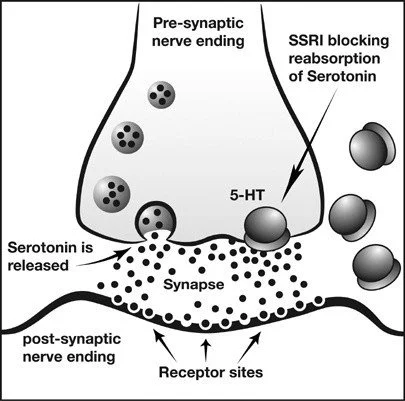The Science of Mental Health
Medications
How popular psychiatric medications, like Lexapro, affect the inner workings of the brain and body
Written by: Laura Schusser | Edited by: Maria Teresa Mata | Photo by: Cottonbro Studio
Anxiety has become the most common class of psychiatric disorders, with a lifetime prevalence in the US of around 32%, and this number continues to escalate with the influence of social media in today’s generation. The most common anxiety disorders, namely Generalized Anxiety Disorders (GAD), are influenced by both environmental and genetic factors. Some symptoms of GAD include irritability, apprehensiveness, fatigue, a feeling of dread, and a high heart rate. To address these symptoms, the Food and Drug Administration (FDA) approves the use of selective serotonin reuptake inhibitors (SSRIs) and serotonin-norepinephrine reuptake inhibitors (SNRIs). Several examples of medications in these categories include Escitalopram (Lexapro), Sertraline (Zoloft), Paroxetine (Paxil), Venlafaxine (Effexor XR), and Duloxetine (Cymbalta). The duration of these treatments can vary, anywhere between 3-6 months and 1-2 years. A recent meta-study highlighting the efficacy of these treatments showed that the most effective medications within the SSRI and SNRI classes are Escitalopram (Lexapro) and Duloxetine (Cymbalta) respectively. Despite the widespread use of these drugs, many lack an understanding of how they physically affect the body.
Let’s take a look at the bodily manifestation of Lexapro—a drug with over 30 million prescriptions in the United States as of 2022. A psychiatrist will often prescribe Lexapro in doses ranging from around 5mg/day to 30 mg, depending on severity. After oral ingestion, this medication makes its way through the digestive system and is distributed throughout the body via the circulatory system, reaching its main target site: the brain. There, it binds to proteins called serotonin transporters (SERT) in presynaptic neurons. These protein transporters facilitate the reuptake of key chemical messengers called serotonin, which is responsible for carrying messages between nerve cells to help indicate feelings of pleasure and happiness. Therefore, when Lexapro binds to and deactivates SERT receptors, less serotonin is recycled, so more can travel to the postsynaptic neuron—the cell that actually modulates the effect.
Diagram of SSRI blocking reuptake of serotonin
This cascade continues throughout the brain, allowing for an increased effect on mood and positive mental outlook. Once Lexapro has exerted its effects, it travels via the blood to the liver, where it is metabolized and broken down by hepatocyte cells. From there, the Lexapro remnants are excreted via the urine around 27-33 hours after initial ingestion.
The process described works to different extents based on genetic and environmental factors. Many of the other drugs mentioned function similarly to Lexapro, with slight variations in their effects. For patients, understanding the inner workings of their medications is vital to effective health management. By having a clear grasp of how these medications work, patients can make informed decisions about their treatment. With increased awareness, they can also acquire a greater sense of control and comfort in their mental health journey. Therefore, the healthcare system should focus on medication education–making these complex mechanisms, like the physical manifestation of Lexapro, more digestible for users. By breaking down these complex scientific mechanisms into understandable terms, the scientific community can expand user education and normalize taking pharmacological treatments for mental health purposes.
These articles are not intended to serve as medical advice. If you have specific medical concerns, please reach out to your provider.

